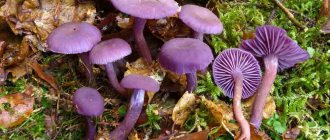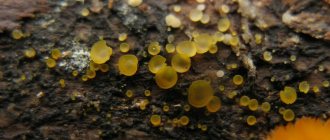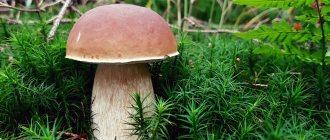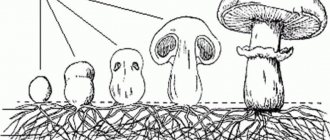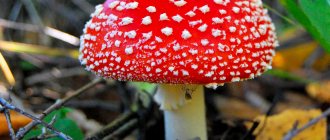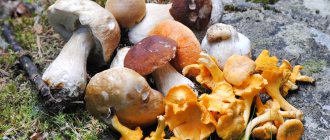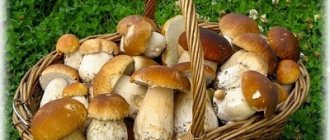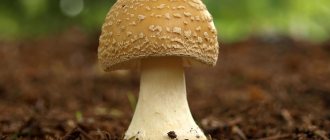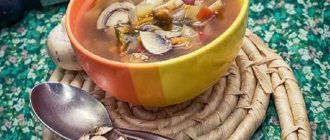Blue milkweed, in Latin Lactarius indigo, is a type of edible mushroom belonging to the genus Lactaceae, from the Russula family. It is unique for its color. Indigo color is not often found among representatives of the taxon, and such a rich color is very rare for edible mushrooms. The species is not found in the countries of the former Soviet Union.
Despite its exotic appearance, the mushroom is edible
Blue milky (Lactarius indigo.
A fairly common type of mushroom, it grows in eastern North America, eastern Asia and central America. It grows on the ground in both deciduous and coniferous forests. The color varies from dark blue in fresh mushrooms to pale blue-gray in old ones. The milk that the mushroom produces when cut or broken is also blue. The cap is 5-15 cm, the leg is 2-8 cm in height and 1-2.5 cm in thickness. The mushroom is edible and sold in rural markets in Mexico, Guatemala and China
.
Devil's Cigar
Devil's cigar (Chorioactis geaster) is a very rare mushroom that can only be found in Texas and the Japanese islands of Kyushu and Honshu. The fungus usually grows on old stumps and dead roots of trees such as oaks and elms. At the beginning of the growing season, it looks like a dark brown cigar. At the moment of ripening, the upper part of the mushroom opens and a cloud of spores, similar to smoke, emerges from the fruiting body. At the same time, a hissing sound is heard. It is believed that the devil's cigar is the only mushroom that makes sounds. He is often also called the Texas Star.
Unusual mushrooms. The most unusual representatives of the mushroom kingdom
Mushrooms can be very different in shape, size and variations in adaptability. Their number is incalculable. Therefore, we will present only the most amazing mushrooms in the world.
Lampshade mushroom Parasola plicatilis
The resemblance to a floor lamp is given to these creatures by the folded cone-shaped cap rising on a thin elegant leg. The folded dung beetle grows in large families. Having met a large family of these amazing capped mushrooms at the edge of the forest, it may seem that you find yourself in a miniature gallery of chandeliers, intended for tiny inhabitants of the underground kingdom - gnomes.
Devil's fingers Clathrus archeri
Those who see Archer's Clathrus for the first time do not immediately realize that what they are looking at is not a starfish or a lovely cactus, but a real mushroom. The young ovoid fruiting body is decorated with 3 to 8 lobes branched like tentacles. When unfolded, they form an unusual flower with star-shaped petals 10-15 cm in diameter. The “petals” emit an unpleasant odor that attracts insects.
Star mushroom Myriostoma coliforme
The unusually shaped mushroom is the only representative of the Myriostome genus. It can have a spherical or flattened cap, dotted with a scattering of small holes. Its size before opening is only 1-5 cm, and after it reaches a diameter of 6-10 cm. For such an unusual shape, Myriostoma received a second name - octopus.
Myriostoma cervicalis is extremely rare in forests. It grows in single specimens, and therefore is not easy to find.
Turkey tail Trametes versicolor
Trametes variegated, which prefers to grow sideways on wood, is interesting for its unusual coloring of the fruiting body. The flat caps, often fused with each other, are colored with variegated stripes. Their color palette is very diverse, starting with blue and silver and ending with emerald, burgundy and black. Thanks to its bright color, it is impossible to confuse it with other representatives of the mushroom kingdom. Polypores grow in small groups. They settle on stumps, logs and deciduous trees. Although colorful mushrooms are inedible, they are widely used in medicine. In Japan they are used to treat oncology, in China they are used to restore the functioning of the immune system.
Glow in the dark panellus
Panellus, whose name is translated from Latin as “cookie” or “bread”, is interesting not only for its unusual shape of the fruiting body, but also for its unique ability to bioluminesce. Its cap is initially kidney-shaped, but as it develops it becomes ear-shaped and fan-shaped. A small cap, the diameter of which is no more than 3-4 cm, is covered with dozens of tiny cracks. The luminous properties appear as a result of a chemical reaction involving oxygen and luciferin. Thanks to this, panneluses, which prefer to settle on the trunks of beech, oak and birch trees, glow with a green glow in the dark.
Variegated Trametes or Turkey Tail
This mushroom is distributed throughout the world, but this does not underestimate its uniqueness and beauty. It grows on trees, spreading out layer after layer of multi-colored circles. This is why it is often called the peacock's tail. Over time, the core of the mushroom becomes dark in color or even black.
Turkey tail is considered a medicinal mushroom. It is widely used in Japanese medicine. It is also believed to help treat cancer, but this has not been clearly established.
Amethyst varnish. Distribution and description of the amethyst (lilac) fungus
Purple mushrooms, as a rule, do not make you want to immediately pick them up and put them in a basket. However, among these species with a rich mystical color there are quite edible ones - such as, for example, the elegant amethyst varnish, especially bright when young.
Amethyst lacquer (Laccaria amethystina) or lilac lacquer is an edible mushroom belonging to the Ryadovkov family, the genus Lakovitsa. It has the following characteristic species characteristics:
- As the fruiting body develops, the convex cap with a felt surface becomes flat-spread, with barely noticeable scars and light strokes along the edge. The beautiful lilac color becomes less saturated with age - whitish, pinkish. The same color fading occurs in dry weather. The size of the cap is small - from 2 to 5 cm;
- wide, sparsely spaced plates adhere to the stem and somewhat descend along it. Their color is also purple; when the spores ripen, they become lighter;
- spores are light purple to white;
- the fibrous cylindrical hollow stalk with white fibers at the base is painted in lilac tones. Grows from 3 to 10 cm in length with a maximum diameter of 0.8 cm;
- the flesh is also purple, watery, thin in the cap, with a pleasant mushroom aroma and delicate taste. The flesh of the leg with coarse fibers is much drier and tougher.
Places of distribution and fruiting period
Lilac lacquer grows on moist soils, mossy areas of coniferous, mixed and deciduous forests, including under oaks and beeches. Often found in groups, forming small clumps. Appears from mid-July and bears fruit abundantly until October.
Similar types and differences from them
The most dangerous similarity between amethyst lacquer and mycena pura is a poisonous species that grows in the same areas, often in close proximity, and is colored in lilac-brown shades. The main differences between pure mycena are white or grayish plates and a distinct rare smell.
Young violet spiderworts (Cortinarius violaceus) are similar in color to amethyst varnish, but these edible mushrooms are much more massive and larger, and their plates are covered with a fibrous blanket. As they grow, the caps of purple web spiders become brown in color.
In dry weather, heavily faded amethyst lacquers can be confused with their edible relative, rose lacquer (Laccaria laccata).
Edibility
Amethyst varnish belongs to category 4 edible mushrooms. Only its caps are edible. You can cook a picturesque roast from the mushroom.
At the same time, given that its fruiting bodies accumulate arsenic if it is present in the soil, it is wiser to add them to mushroom dishes little by little, combining them with other edible varieties.
Beautiful amethyst varnishes are quite widespread and are clearly visible both on the damp forest floor and among green moss. It is important to distinguish them from their dangerous poisonous neighbors, collect only the caps and cook them as part of a mushroom platter.
Raincoats
There are quite a few varieties of puffball mushroom. They all belong to the champignon family and each species has its own unique characteristics. But there is something that unites them. They have a pear-shaped structure with a closed cap, that is, the stem is hidden inside the mushroom.
While the mushroom is young, it is hard and elastic, but as it matures, the spores inside turn into a gray dusty mass. They are sprayed through the resulting hole that appears in the cap.
Popularly, this type of unusual mushroom is often called “poofs”, because of the characteristic sound and effect that appears after hitting the mushroom with your foot.
3
Milky blue mushroom. Milky: photo and description of the genus of mushrooms. What do lacticians look like?
Milky mushrooms are mushrooms with thin or thick fleshy, dense but brittle fruiting bodies, mostly of medium or large size. Their cap and stem are homogeneous (homogeneous) and do not separate from each other without breaking, like, for example, a champignon. There are stocky mushrooms with a thick stem, approximately equal in length to the diameter of the cap (Lactarius deliciosus, Lactarius pubescens, Lactarius turpis), and there are also species in which a small cap fits on a long, relatively thin stem (Lactarius camphoratus, Lactarius lignyotus). Fungi of this genus lack both a private and a general veil.
The cap of milkweeds can be funnel-shaped, depressed, convex-spread or convex. In young mushrooms it is straight or convex with the edge turned down. White or brightly colored (yellow, orange, grey, pink, brown, blue, lilac, olive black), with a wavy, straight or ribbed edge. With age, some mushrooms change the color of their fruiting bodies.
The surface of the milkweed cap is dry or slimy, smooth, scaly, fleecy or velvety, plain or with concentric circular zones and depressions - lacunae. The cap size is from 8 to 40 cm (Lactarius vellereus). In the stunted milkweed (lat. Lactarius tabidus) and dark milkweed (lat. Lactarius obscuratus) the cap is capable of swelling, absorbing water.
The milkweed is stunted. Photo credit: Jerzy Opioła, CC BY-SA 3.0
Pink wave. Photo credit: Jomo, Public Domain
The hymenophore of these mushrooms is lamellar. The lamellar plates descend to varying degrees on the stalk, attaching to it strongly in some species and slightly in others. The plates with anastomoses or notched are either white or painted in bright colors: pink, bluish, pale ocher, cream. Can change color when touched. For example, the plates of the lilac milkweed (lat. Lactarius violascens) are initially white or creamy yellow, but when squeezed they become purple.
Spruce mushroom. Photo credit: Andreas Kunze, CC BY-SA 3.0
A characteristic feature of laticifers and russula in general is the mesh pattern on their spores. The cells themselves, intended for reproduction, are often spherical, broadly oval or oval in shape. The spore powder is white, ocher or yellowish-cream.
Spores of the aromatic milkweed under a microscope. Photo credit: Jason Hollinger, CC BY-SA 2.0
The leg of the milkweed is attached to the cap in the center; its shape is regular cylindrical, flattened or narrowed towards the base. It is white or the same color as the cap, sometimes hollow inside, more often with chambers or filled. The surface is smooth, dry, less often mucous and sticky.
Some species have depressions (lacunae) that are colored slightly darker than the rest of the skin of the leg. The height of the leg of the milkweed is 5-8 cm, its diameter is 1.5-2 cm.
Milky is neutral. Photo credit: Andreas Kunze, CC BY-SA 3.0
The pulp of the milkweeds is fragile, white or with a brown, cream or fawn tint. In air it can change color. It contains conducting thick-walled hyphae with milky juice.
The color of the milky sap and its change in air are an important systematic feature by which species of the genus are distinguished. Most often it is white, but in some species in the air it slowly turns green, gray, yellow, purple, red, etc. In the North American blue lactifer (lat. Lactarius indigo), the juice, like the entire fruiting body, is blue.
Gorkushka. Photo credit: Andreas Kunze, CC BY-SA 3.0
Blue milky. Photo credit: Mason Lalley, CC BY-SA 3.0
Useful properties, medical use and restrictions on use
Milky mushrooms have been used since ancient times in folk medicine to treat purulent wounds, kidney diseases and other diseases. Most species have antitumor and antibacterial effects. The fruit contains vitamins that have a beneficial effect on the nervous system and serve to prevent the development of sclerosis.
Gruzd
Medicines made from milk mushrooms help cope with kidney stones. Blue mushroom contains a natural antibiotic that has a detrimental effect on staphylococci. Scientists have discovered lactarioviolin in some fruits, an antibiotic that helps destroy tuberculosis pathogens.
Most mushrooms of this genus are conditionally edible fruits, so they need heat treatment before consumption. You cannot harvest crops near highways, factories and factories; it is better to do this in environmentally friendly areas. It is not recommended to eat these fruits if you have gastrointestinal diseases, pregnancy or breastfeeding.
Recipes and cooking features
Mushrooms of this kind can be fried, boiled and pickled, but in this form their taste is muted. Salted and fermented milkweeds are characterized by good taste. Saffron milk caps do not require long-term soaking, but bitter mushrooms, milk mushrooms and milk mushrooms should be soaked for some time in cold water.
Here are some delicious recipes:
- If the basket is filled with saffron milk caps, this is an excellent reason to please your loved ones with fried mushrooms. The harvest is washed and cleared of forest debris. Each specimen is cut into 5-7 parts and placed in a heated frying pan with sunflower oil.
Fried saffron milk caps
The heat should be medium so that the water from the mushroom mass evaporates faster. When the water boils, reduce the heat and fry for about 15 minutes. At this time, you can add finely chopped onion, salt and fry for about five more minutes. - To prepare delicious mushrooms in Korean, you will need the following ingredients:
- lacticaria (any bitter mushrooms);
- soy sauce;
- table vinegar;
- fresh garlic;
- hot pepper;
- ground coriander.
Milkmen in Korean
sugar;
The fruits are pre-boiled 2-3 times for 30 minutes, changing the water each time. It is desirable that they retain a slightly bitter taste, which will give the dish a special piquancy. Boiled fruits are seasoned with soy sauce, sugar is poured in and a little vinegar is poured in. The resulting mass is thoroughly mixed with the addition of the necessary spices. The finished dish should be allowed to brew for several hours in the refrigerator.
Caesar mushroom. Where does the Caesar mushroom (royal mushroom) grow, its description and similar species
The edible Caesar or royal mushroom is described, the places of its distribution, the fruiting season are given, and similar species are listed.
The diverse mushroom community has its own aristocracy. Since ancient Rome, the fleshy yellow-orange member of the fly agaric family has been called the “royal mushroom” or “Caesar’s mushroom.” They loved to serve it at elite ancient feasts. However, this spectacular species has not lost its culinary position to this day.
Caesar's mushroom (Amanita caesarea) is edible, has synonymous names: Caesar's fly agaric, Caesar's mushroom, Caesar's fly agaric, Caesar's mushroom and the following species differences:
- the development of the fruiting body begins in an egg-shaped cocoon formed by a thick white blanket;
- cap with dry orange-yellow skin. The color can vary from golden to bright red. The minimum diameter of the cap is 8 cm, the largest is 20 cm. Its shape changes as it develops from convex hemispherical to flat. Edges with radial grooves. White blanket flakes on the surface are usually completely absent;
- Golden-yellow, frequently located soft plates do not grow to the stem. They widen in the middle part;
- whitish spores;
- cylindrical leg; with a club-shaped base covered by a wide, bag-shaped, free volva, the width of which reaches 50 mm. The maximum dimensions of the leg are length 16 cm, thickness 3 cm. The color is orange-yellow, the hanging ring of the same color is clearly visible. Above the ring there are faint stripes;
- The fleshy flesh of the cap has a yellowish color under the skin. The flesh of the leg is pure white. There is no pronounced aroma or taste. Only very old, overripe specimens acquire an unpleasant odor of hydrogen sulfide.
Distribution and fruiting period
This fungus inhabits warm, dry areas of sandy soil in oak and chestnut groves. It is found quite often, grows in groups, prefers the southern regions of the European forest belt, and has even been recorded in the subtropics. In warm climates, fruiting bodies ripen in the fall.
Similar species
The Caesar mushroom has dangerous, poisonous counterparts, and similarities with them are characteristic of different stages of development.
While the growing fruiting body is in a light egg-shaped shell, it is difficult to distinguish it from the deadly one (Amanita phalloides) located in a similar cocoon. The cut decides everything - even inside the cover, all parts of the Caesar mushroom, especially the cap, are painted golden yellow. The young pale grebe, as it should be, has only a yellowish-greenish tint.
Grown-up Caesar mushrooms sometimes acquire not just orange, but bright red color and become similar to poisonous red fly agarics (Amanita muscaria). You can confidently distinguish them by carefully examining the cap and stem. The red fly agaric is most often dotted with white flakes; a short ring-shaped volva grows to the base of the stalk. The Caesar mushroom has a smooth cap, without flakes or with single white scales, and a wide, free volva covers the bottom of the stem with a spacious sac.
The royal mushroom also has an edible double, a close relative with the same golden stalk covered by a wide volva, but with a bright scarlet cap - the Far Eastern Caesar mushroom (Amanita caesareoides), often found in autumn deciduous groves in the south of the Primorsky Territory.
Edibility
The taste qualities of the Caesar mushroom were glorified in ancient poems - it was served to selected guests of ancient Roman gourmets. The fruiting bodies of this species are prepared without pre-treatment - baked, fried and dried. At the “egg” stage, they are crumbled raw into salads. However, in order to freely use royal mushrooms for preparing delicious dishes, it is necessary to reliably distinguish them from their poisonous relatives.
“Royal” hats the color of red gold often appear in the velvet autumn in the southern regions of the forest zone. Experienced mushroom pickers have every chance to reap a rich “Caesar” harvest and join in the culinary delights of ancient authors. At the same time, it is vitally important to have a good knowledge of the species characteristics of royal mushrooms, which have a dangerous resemblance to toxic fly agarics.
The grate is red. Description and distribution locations of the red trellis
Some representatives of the mushroom kingdom are so unusual in their structure, color and shape that they look more like works of abstract art than an object of living nature. Most of them grow and bear fruit in the tropical rainforests of the far southern latitudes. On the territory of Russia, the red trellis is occasionally found - a mushroom with a very bright color and a completely unusual structure.
Description
Inedible, but beautiful in its own way, the red trellis (Clathrus ruber) or red clathrus, is part of the Vesperaceae family, a class of Agaricomycetes. It has neither a cap nor a leg.
Its appearance can be described as follows:
- In the initial stage of growth, red latticeworts resemble puffballs, with which they are distantly related. The young fruiting body is round-ovoid, up to 6 cm high and up to 5 cm in diameter, covered with a whitish or brownish leathery shell. Beneath it lies another thick mucous-gelatinous layer, and in the depths a coarse receptacle develops - a dome-shaped mesh structure;
- As it matures, the outer thin shell bursts in a star-shaped manner and quickly disintegrates, remaining only at the very base of the deep red, occasionally whitish or yellowish receptacle. At this stage, the mushroom looks exactly like a bright scarlet spherical convex lattice with polygonal rounded cells. Reaches a diameter of 9 cm, a height of up to 12 cm;
- the inner surface of this structure is covered with a dark mucous spore mass of olive-green color, emitting a distinct and rather pungent putrefactive odor that attracts spore-carrying insects;
- The flesh is spongy and tender.
Distribution and fruiting season
The red trellis grows, as a rule, under broad-leaved trees, on humus-rich soils with a moist litter of fallen leaves and the remains of rotting wood. In exceptional cases, its bright fruiting bodies may appear in mixed forests. The heat-loving red latticeworker survives only where winter temperatures do not drop below -5 ºС, therefore it is found mainly in the southernmost regions - the Krasnodar Territory, Crimea and the Caucasus. In the Moscow region, the only case of ripening of this mushroom was recorded. It also develops well in warm and humid greenhouse conditions if its spores are placed in tubs along with soil for tropical plants.
The red trellis bears fruit from spring to autumn, as local climatic conditions allow. An interesting fact is that it does not grow every year, but at intervals of several years. This mushroom is very rare and ripens singly or in small groups. Listed in the Red Book as an endangered and protected species - the only representative of lattice beetles on the territory of the Russian Federation.
The large-celled fruiting body of a mature red trellis is a rare and surprising find. Although the scarlet mushroom with an unpleasant odor does not have the slightest nutritional value, its unusual appearance indicates that inventive nature works no worse than an avant-garde sculptor. Since this is a rare species listed in the Red Book of Russia, found lattice mushrooms should be reported to environmental organizations that keep records and cartographically record the places of settlement of such fungi.
